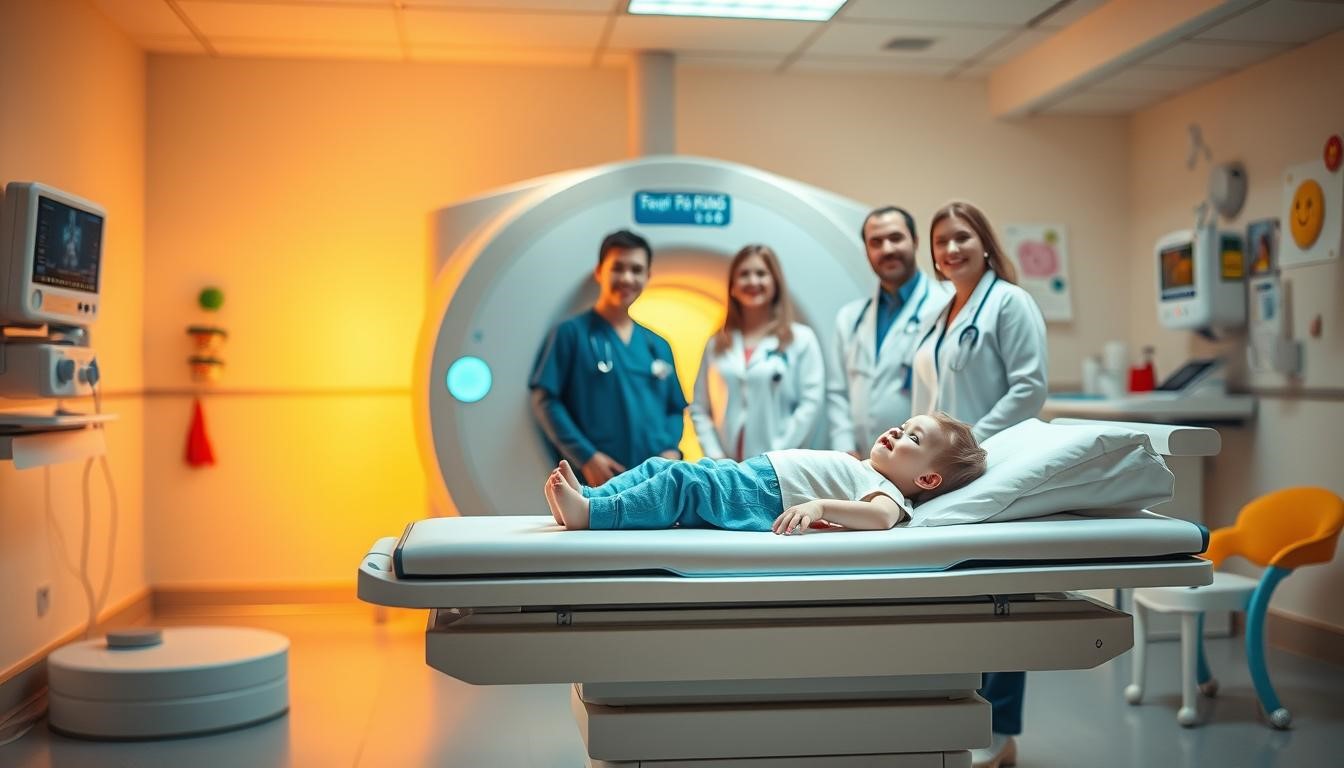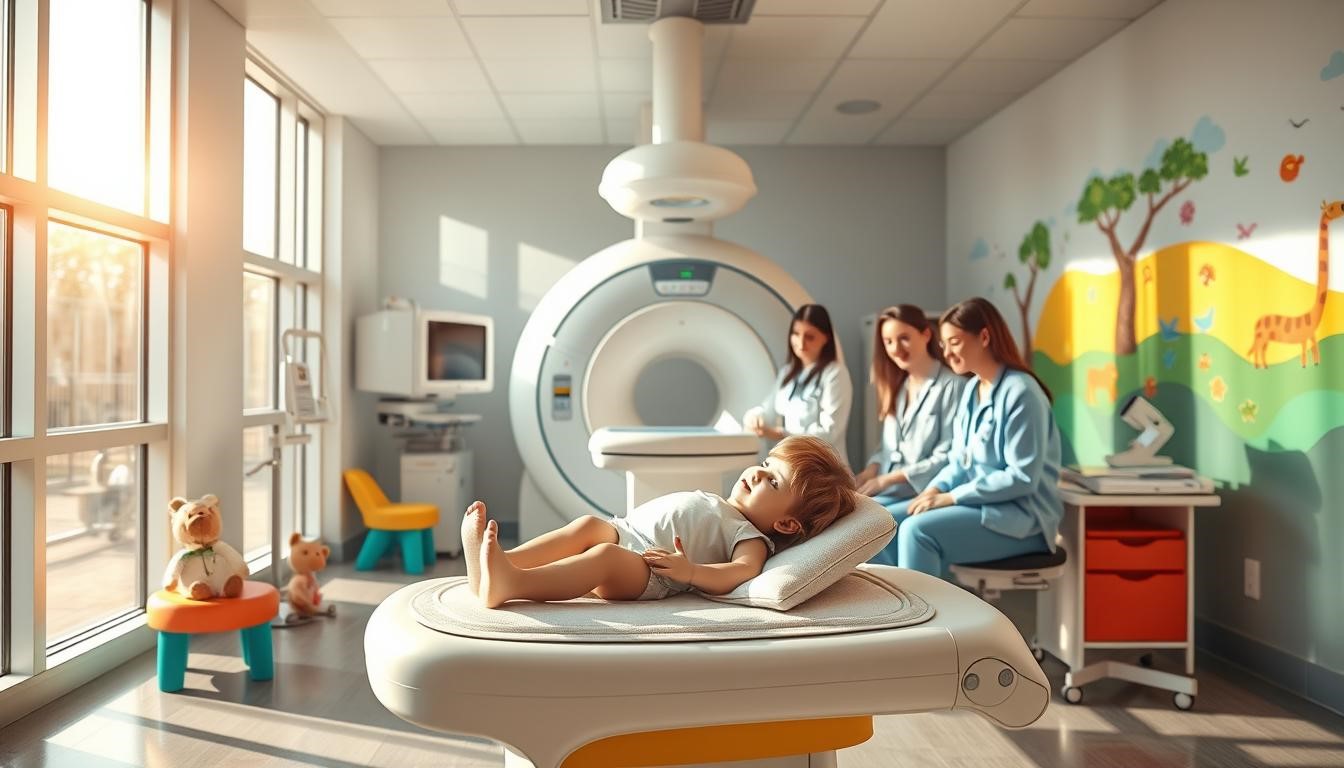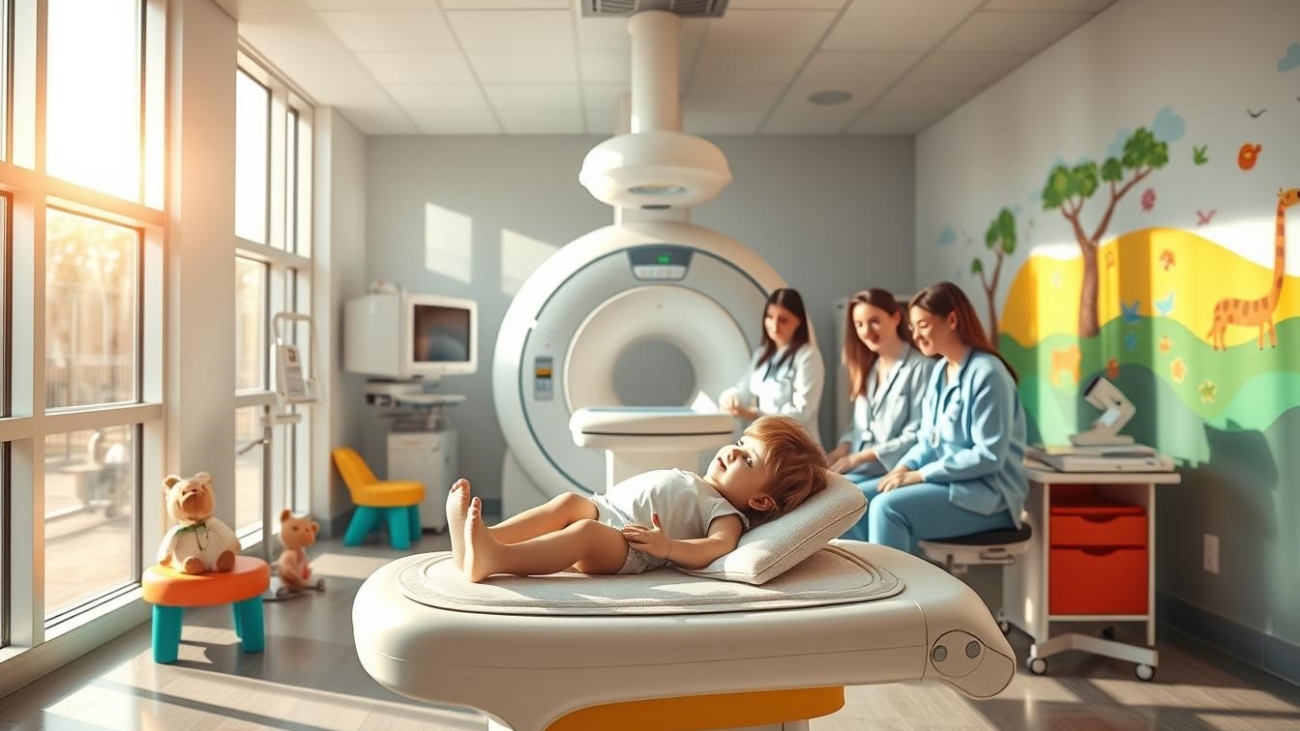PediPediatric imaging needs a special touch to help children. Gentle Imaging Techniques are key in Child Imaging. They help get accurate diagnoses without causing too much pain or risk.
Imaging kids is different from adults. It requires special methods and tools. These are designed to meet the unique needs of young patients, ensuring they get the best care.
This article will dive into why pediatric radiology is so important. We’ll look at the challenges of imaging children and the advanced methods used to tackle them. It will give a full picture of this vital field.
The Unique Challenges of Pediatric Imaging
Imaging children is not just about making adult procedures smaller. It needs a special approach. Pediatric radiology requires knowing the unique features of children’s bodies and minds.
Anatomical and Developmental Differences
Children’s bodies grow and change a lot. Their anatomy is different from adults. Smaller size, changing bone density, and growing organs need special imaging methods. It’s also important to use lower radiation doses to protect them.
Psychological Considerations When Imaging Children
Imaging can scare children, causing them to feel anxious. Radiologists must think about how imaging affects children’s minds. They should use simple language, reassure them, and involve parents. This helps make the experience less scary.
Building Trust with Young Patients and Their Families
Building trust is key for successful pediatric imaging. Radiologists and staff need to understand and support children and their families. They should explain things clearly and offer emotional support. This helps reduce anxiety and makes the process smoother.
Specialized Radiology Techniques for Pediatric Patients
Specialized radiology techniques are key in pediatric care. They offer gentle and accurate imaging solutions. These methods tackle the unique challenges of imaging children, including anatomical and developmental differences, and psychological considerations.
Child-Specific Imaging Protocols
Pediatric radiology departments create child-specific imaging protocols. These ensure diagnostic imaging is safe and effective for young patients. The protocols take into account the child’s age, size, and the clinical question being addressed.
Tailored imaging protocols reduce the need for repeat exams. This lowers radiation exposure and boosts diagnostic accuracy.

Radiation Dose Management and Safety
Managing radiation dose is vital in pediatric radiology. Techniques like adjusting exposure settings on radiography and CT equipment are key. Using alternative imaging modalities like ultrasound or MRI when needed also helps minimize radiation exposure.
• Implementing ALARA (As Low As Reasonably Achievable) principles guides radiation dose management.
• Regularly maintaining and calibrating equipment ensures optimal performance.
• Training staff on radiation safety and dose optimization is essential.
Equipment Modifications for Pediatric Applications
Pediatric imaging needs equipment designed for children’s smaller size. Modifications include using size-appropriate devices and making comfort-enhancing adaptations. These help reduce anxiety and improve image quality.
Size-Appropriate Devices
Using devices designed for pediatric patients ensures safe and effective imaging. This includes pediatric-specific coils for MRI and appropriately sized detectors for radiography.
Comfort-Enhancing Adaptations
Adaptations like pediatric-friendly immobilization devices and comfort measures during imaging are vital. They reduce distress and improve the experience for children and their families.
By using these specialized techniques and equipment modifications, pediatric radiology advances. It provides high-quality diagnostic imaging that meets the unique needs of children.
Common Pediatric Radiology Procedures and Applications
Radiological imaging is key in pediatric care, with several important procedures. These help doctors assess and treat children’s health issues. From fractures and infections to complex birth defects, pediatric radiology is essential.
X-rays for Growth Assessment and Fracture Detection
X-rays are vital in pediatric radiology. They help check bone growth and find fractures. Modern X-rays use low radiation, making them safe for kids.
Ultrasound Benefits in Pediatric Diagnosis
Ultrasound is a top choice in pediatric care. It’s non-invasive and doesn’t use harmful radiation. It’s great for looking at organs, checking the heart, and guiding treatments. Ultrasound’s live images are perfect for kids, who can move around.
CT and MRI: Indications and Considerations
CT and MRI scans give detailed views of inside the body. They’re key for complex diagnoses. CT scans are quick and detailed, while MRI shows soft tissues well without radiation. Choosing between them depends on the child’s size and the specific question.
Nuclear Medicine Studies for Children
Nuclear medicine uses tiny amounts of radioactive tracers. In kids, it helps check organ function, find infections, and spot cancers. The tracers are chosen to keep radiation low while getting important info.
Interventional Radiology in Pediatric Care
Interventional radiology uses imaging to guide small procedures. In kids, it can include biopsies, drainages, and vascular work. It’s a less invasive option than surgery, helping kids recover faster.
Creating Child-Friendly Imaging Environments
A well-designed imaging environment greatly improves care for kids. It makes the experience better and helps get accurate results.
Physical Space Design and Atmosphere
The space for imaging should be designed for kids. Use bright colors, fun decor, and games to keep them distracted.
Key elements of a child-friendly imaging environment include:
• Comfortable seating for families
• Toys and entertainment for children
• Clear explanations and preparation materials
Age-Appropriate Preparation Techniques
It’s important to prepare kids for imaging in a way they can understand. Explain it simply, use pictures, or even practice with mock scans.
Parental Involvement During Procedures
Having parents there can comfort a child. But, parents need to know their role and how to support their child.
Sedation and Anesthesia Approaches
Sometimes, sedation or anesthesia is needed for the child’s comfort and the procedure’s success.
When Sedation Is Necessary
Sedation is used when a child can’t stay calm or is too nervous. The choice depends on the child’s health, age, and the imaging needed.
Minimizing Risks and Recovery
When sedation or anesthesia is used, it’s key to watch the child closely. Have emergency plans ready. Afterward, watch for any bad effects and help with recovery.
Pediatric radiology has made great strides in providing safe and effective imaging for kids. Looking ahead, we see more advancements in Pediatric Radiology Advances. These will help improve how we diagnose and treat young patients.
By using imaging methods made for kids, managing radiation, and making places friendly for children, radiologists can reduce stress. New technologies and techniques will also help. This means better care for kids, tailored to their needs.
As we move forward, focusing on the well-being of children is key. This approach ensures Pediatric Radiology Advances meet kids’ needs. It leads to better health and a better life for them.
FAQ
What is pediatric radiology?
Pediatric radiology focuses on imaging and diagnosing children. It uses X-rays, ultrasound, CT, and MRI. It covers newborns to teens.
Why is pediatric radiology important?
It’s key because kids’ bodies are growing and different from adults. They need special imaging methods and tools for safe and effective scans.
What are some common pediatric radiology procedures?
Procedures include X-rays for growth and fractures, ultrasound for belly and pelvic issues. CT and MRI scans are for detailed images. Nuclear medicine studies check organ function.
How do radiologists prepare children for imaging procedures?
Radiologists use simple explanations and child-friendly language. They offer emotional support to make kids feel at ease during scans.
What role do parents play during pediatric imaging procedures?
Parents are very important. They help calm their child’s fears and provide reassurance. They also help keep their child steady during the scan.
Are sedation and anesthesia used in pediatric radiology?
Yes, sedation and anesthesia are used when needed. They help kids stay calm and steady during scans. But, they’re used carefully, considering the child’s age and health.
How is radiation exposure managed in pediatric radiology?
Radiation exposure is managed by using special imaging protocols for kids. The goal is to use the least amount of radiation. Non-radiation methods like ultrasound and MRI are also used.
What are some of the challenges faced in pediatric radiology?
Challenges include needing special equipment and techniques. Managing radiation exposure is also a big challenge. Plus, there are unique anatomical and developmental differences in kids, as well as their emotional needs.


Add a Comment